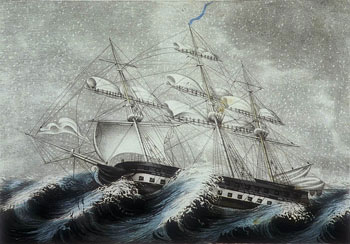"The passage around Cape Horn, into the Pacific, is generally very trying and hazardous, owing to the violent westerly gales and sudden squalls that prevail in those regions. Ships are sometimes detained here for two or three weeks and even longer, contending against the fury of the elements. To the howling storm and the raging sea, the iceberg, a common exhibition, adds new terrors, which the most careful vigilance cannot always elude. Many a ship has been crushed between these moving mountains, or been dashed to pieces upon fields of floating ice, and every soul perished in these forlorn regions."
Ice was also a serious threat as whalemen went further north to hunt for sperm whales, which had become harder to find by the 1840s. Whaling off the coast of Alaska meant taking the chance of getting stuck in retreating ice shelves and more ships were lost this way than by any other cause combined. In 1871 an entire fleet of 33 ships was lost and again in 1876, 20 were lost. In 1871, the loss of this fleet from New England left 1,200 people shipwrecked and caused the loss of over one million dollars to New Bedford alone. The most amazing part of this catastrophe is that, in spite of the number of ships lost and the dangers the people faced, not a single life was lost because they were able to make their way down the coast, south of the ice, where there were several other ships.
![]() Jump to More About...:
Whaling Disaster of 1871
Jump to More About...:
Whaling Disaster of 1871

Mystic Seaport